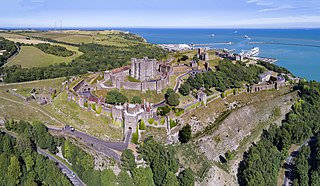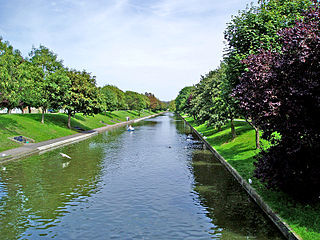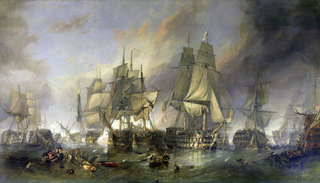 W
WNapoleon's planned invasion of the United Kingdom at the start of the War of the Third Coalition, although never carried out, was a major influence on British naval strategy and the fortification of the coast of southeast England. French attempts to invade Ireland in order to destabilise the United Kingdom or as a stepping-stone to Great Britain had already occurred in 1796. The first French Army of England had gathered on the Channel coast in 1798, but an invasion of England was sidelined by Napoleon's concentration on campaigns in Egypt and against Austria, and shelved in 1802 by the Peace of Amiens. Building on planning for mooted invasions under France's Ancien Régime in 1744, 1759 and 1779, preparations began again in earnest soon after the outbreak of war in 1803, and were finally called off in 1805, before the Battle of Trafalgar.
 W
WThe Raid on Boulogne in 1804 was a naval assault by elements of the Royal Navy on the fortified French port of Boulogne, during the Napoleonic Wars. It differed from the conventional tactics of naval assaults of the period by utilizing a wide range of new equipment produced by the American-born inventor Robert Fulton, with the backing of the Admiralty. Despite its ambitious aims the assault produced little material damage to the French fleet anchored in the harbour, but did perhaps contribute to a growing sense of defeatism amongst the French as to their chances of crossing the English Channel in the face of the Royal Navy and launching a successful invasion of the United Kingdom.
 W
WBoulogne-sur-Mer, often called just Boulogne, is a coastal city in Northern France. It is a sub-prefecture of the department of Pas-de-Calais. Boulogne lies on the Côte d'Opale, a touristic stretch of French coast on the English Channel between Calais and Normandy, and the most visited location in the region after the Lille conurbation. Boulogne is its department's second-largest city after Calais, and the 183rd-largest in France. It is also the country's largest fishing port, specialising in herring.
 W
WThe raid on Boulogne in 1801 was a failed attempt by elements of the Royal Navy led by Vice Admiral Lord Horatio Nelson to destroy a flotilla of French vessels anchored in the port of Boulogne, a fleet which was thought to be used for the invasion of England, during the French Revolutionary Wars. At dawn on 4 August, Nelson ordered five bomb vessels to move forward and open fire against the French line. Despite the inferior gunpowder of French artillery and the high number of shots fired by the bomb vessels, the British sustained more casualties and withdrew. The night of 16 August Nelson returned and tried to bring off the flotilla, attacking with seventy boats and nearly two thousand men organized into four divisions, but the attack was successfully repelled by the defenders, led by Admiral Latouche Tréville.
 W
WBritish anti-invasion preparations of 1803–05 were the military and civilian responses in the United Kingdom to Napoleon's planned invasion of the United Kingdom. They included mobilization of the population on a scale not previously attempted in Britain, with a combined military force of over 615,000 in December 1803. Much of the southern English coast was fortified, with numerous emplacements and forts built to repel the feared French landing. However, Napoleon never attempted his planned invasion and so the preparations were never put to the test.
 W
WThe Volunteer Corps was a British voluntary part-time organization for the purpose of home defence in the event of invasion, during the French Revolutionary and Napoleonic Wars.
 W
WÉtienne Eustache Bruix was a French Navy officer and admiral, and Minister of the Navy.
 W
WIn the Battle of Cape Finisterre off Galicia, Spain, the British fleet under Admiral Robert Calder fought an indecisive naval battle against the combined Franco-Spanish fleet which was returning from the West Indies. Failing to prevent the joining of French Admiral Pierre de Villeneuve's fleet to the squadron of Ferrol and to strike the shattering blow that would have freed Great Britain from the danger of an invasion, Calder was later court-martialled and severely reprimanded for his failure and for avoiding the renewal of the engagement on 23 and 24 July. At the same time, in the aftermath Villeneuve elected not to continue on to Brest, where his fleet could have joined with other French ships to clear the English Channel for an invasion of Great Britain.
 W
WDover Castle is a medieval castle in Dover, Kent, England. It was founded in the 11th century and has been described as the "Key to England" due to its defensive significance throughout history. Some sources say it is the largest castle in England, a title also claimed by Windsor Castle.
 W
WThe Western Heights of Dover are one of the most impressive fortifications in Britain. They comprise a series of forts, strong points and ditches, designed to protect the country from invasion. They were created in the 18th and 19th centuries to augment the existing defences and protect the key port of Dover from both seaward and landward attack; by the start of the 20th century Dover Western Heights was collectively reputed to be the 'strongest and most elaborate' fortification in the country. The Army finally withdrew from the Heights in 1956–61; they are now a local nature reserve.
 W
WThe Flottille de Boulogne was a large fleet of small gunboats, brigs and barges built in Boulogne on the orders of First Consul Napoléon Bonaparte from 1801. It was a key component of Napoleon's planned invasion of the United Kingdom. |coordinates = 50°43′27″N 1°35′46″E
 W
WThe Royal Military Canal is a canal running for 28 miles (45 km) between Seabrook near Folkestone and Cliff End near Hastings, following the old cliff line bordering Romney Marsh, which was constructed as a defence against the possible invasion of England during the Napoleonic Wars.
 W
WThe War of the Third Coalition was a European conflict spanning the years 1803 to 1806. During the war, France and its client states under Napoleon I, defeated an alliance, the Third Coalition, made up of the United Kingdom, the Holy Roman Empire, the Russian Empire, Naples, Sicily and Sweden. Prussia remained neutral during the war.
 W
WThe Battle of Trafalgar was a naval engagement between the British Royal Navy and the combined fleets of the French and Spanish Navies during the War of the Third Coalition of the Napoleonic Wars (1803–1815).
 W
WThe Trafalgar campaign was a long and complicated series of fleet manoeuvres carried out by the combined French and Spanish fleets; and the opposing moves of the Royal Navy during much of 1805. These were the culmination of French plans to force a passage through the English Channel, and so achieve a successful invasion of the United Kingdom. The plans were extremely complicated and proved to be impractical. Much of the detail was due to the personal intervention of Napoleon, who as a soldier rather than a sailor failed to consider the effects of weather, difficulties in communication, and the Royal Navy. Despite limited successes in achieving some elements of the plan the French commanders were unable to follow the main objective through to execution. The campaign, which took place over thousands of miles of ocean, was marked by several naval engagements, most significantly at the Battle of Trafalgar on 21 October, where the combined fleet was decisively defeated, and from which the campaign takes its name. A final mopping up action at the Battle of Cape Ortegal on 4 November completed the destruction of the combined fleet, and secured the supremacy of the Royal Navy at sea.